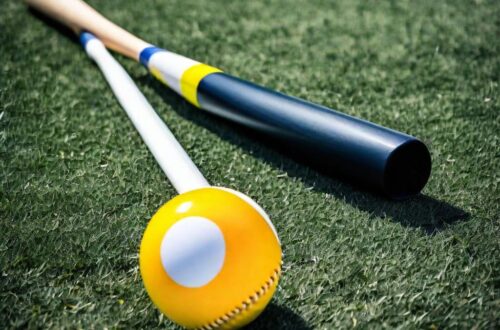Cricket bats are more than just sporting equipment; they’re crafted instruments that embody the essence of the game. From their humble beginnings to today’s advanced designs, cricket bats have evolved significantly, catering to the needs of batsmen across generations.
Introduction to Cricket Bats
Cricket bats are essential tools used by batsmen to score runs in the game of cricket. Beyond their functional role, these bats symbolize skill, technique, and innovation in the sport.

History and Evolution of Cricket Bats
Early Designs and Materials
In the early days of cricket, bats were shaped more like hockey sticks, made from willow wood. These primitive designs gradually gave way to more sophisticated shapes and materials.
Modern Innovations
Today, cricket bats are finely tuned pieces of equipment, optimized for performance through advanced technologies and materials. Innovations in blade profiles and handle designs have revolutionized batting techniques.
Components of a Cricket Bat
Willow Wood: The Ideal Material
The heartwood of the English willow tree is favored for its combination of strength and flexibility, essential for delivering powerful shots.
Handle and Grip Design
The handle of a cricket bat plays a crucial role in control and maneuverability. Different grip designs cater to varying player preferences and batting styles.

Choosing the Right Cricket Bat
Size and Weight Considerations
Selecting the correct bat size is vital for comfort and effectiveness. Bats are available in various sizes to suit players of different ages and physical statures.
Blade Profile Options
The shape and curvature of the bat’s blade influence its performance characteristics, affecting stroke play and power generation.
Famous Cricket Bat Manufacturers
Tradition and Innovation
Companies like Gray-Nicolls, Gunn & Moore, and Kookaburra have established themselves as leaders in cricket bat manufacturing, blending tradition with cutting-edge technology.
Comparison of Popular Brands
Each brand offers unique features and innovations, appealing to different player preferences and styles.
Techniques and Skills in Batting
Grip and Stance
Achieving the correct grip and stance is fundamental for batting success, providing stability and control over shots.
Stroke Types and Execution
From defensive blocks to aggressive drives, mastering various stroke techniques enhances a batsman’s ability to score runs effectively.

Maintenance and Care Tips
Oiling and Knocking-in Process
New cricket bats require careful preparation to ensure durability and optimal performance. Oiling and knocking-in processes help condition the willow wood.
Storage and Longevity
Proper storage and maintenance practices extend the lifespan of cricket bats, preserving their performance characteristics over time.
The Science Behind Cricket Bat Performance
Impact of Bat Design on Batting Style
Bat design influences the distribution of weight and the size of the bat’s sweet spot, crucial for generating power and control.
Sweet Spot and Power Transfer
Identifying the sweet spot—a critical area on the bat’s blade—maximizes the transfer of energy from bat to ball during impact.
Regulations and Standards
Rules Governing Cricket Bat Specifications
International Cricket Council (ICC) regulations stipulate size and dimension limits for cricket bats to maintain fairness and balance between bat and ball.
Changes Over Time
Historical adjustments in cricket bat regulations reflect advancements in technology and the quest for balance between bat performance and game integrity.

Cultural Significance of Cricket Bats
Symbolism in Cricketing Nations
Cricket bats hold cultural significance in countries like India, Australia, and England, where cricket is deeply embedded in national identity.
Collectibles and Memorabilia
Antique and commemorative cricket bats serve as prized collectibles, representing historic moments and cricketing legends.
Innovations in Cricket Bat Technology
High-Tech Materials and Designs
Modern cricket bats integrate advanced materials like carbon fiber and hybrid composites, enhancing durability and performance.
Future Trends
Emerging technologies promise further innovations in cricket bat design, focusing on sustainability and enhanced player performance.
Environmental Impact of Cricket Bat Manufacturing
Sustainability Efforts in the Industry
Manufacturers are increasingly adopting sustainable practices to minimize environmental impact, from sourcing materials responsibly to reducing carbon footprints.
Eco-Friendly Alternatives
Exploration of alternative materials and manufacturing processes aims to create eco-friendly cricket bats without compromising performance.
Challenges in Cricket Bat Design
Balancing Tradition with Innovation
Designers face the challenge of incorporating new technologies while respecting the traditional craftsmanship that defines cricket bats.
Player Preferences vs. Performance Metrics
Meeting the diverse preferences of professional cricketers while adhering to strict performance metrics requires continuous innovation and adaptation.

Global Market Trends
Demand and Supply Dynamics
The global market for cricket bats is influenced by factors such as international tournaments, player endorsements, and consumer trends.
Economic Factors Influencing Sales
Economic fluctuations and consumer spending patterns impact the cricket bat market, driving innovation and competition among manufacturers.
Conclusion
Cricket bats epitomize the fusion of tradition and technology in sports equipment. From their historical roots to cutting-edge designs, these bats continue to evolve, shaping the game of cricket worldwide.




